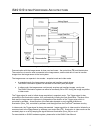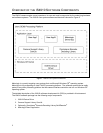
3
O
VERVIEW OF THE
IS4910
S
OFTWARE
C
OMPONENTS
IS4910 Device Driver and Its Configuration Parameters
IS4910 Device Driver is a software component that does all the physical communications with IS4910
camera device. It is pre-compiled as a DLL (vuqdrv.dll) for Windows CE OS and a particular processing
platform and must be properly installed on the target device – please refer to the software installation
instructions below in this document.
The driver provides a set of device-specific functions and so-called IOCTLs, which can be used by the
upper-level software components to communicate with the IS4910 camera. Even though any application
can call these functions, we recommend that user applications use the Camera Support Library APIs
instead of directly calling the driver. The Camera Support Library APIs are described in detail in the
IS4910 Camera Support Library section of this document.
The driver initialization file VuQuest2D.ini can be used by a user to configure the driver per specific
requirements of the user system. This file has the following sections:
• Device
• Pins
• Resources
• Settings
In the Device section, a user can specify the name of sub-key, under which the IS4910 software is going
to be registered in Windows Registry, and the index of the device. The index is used in composition of
the name of the IS4910 device as referenced by the applications. The default name is “VUQ1:”, where
“1” is the default device index. (Note: Changing the device index from default will make the pre-compiled
Metrologic Demo Application inoperable). Also in this section, the user can specify in what directory on
the target device the driver should be installed. By default, the driver is installed in the \windows
directory.
In the Pins section, the user can change the designation of the processor’s general purpose input-output
(GPIO) pins used for communication with the IS4910 camera.
The Resources section can be used to alter the usage of the system resources, such as system interrupts
and DMA channels. In the system for PXA270 processing platform, the SysIntr value specifies the
system interrupt number corresponding to the image capture interface IRQ. If it is not defined or is -1, the
driver obtains it automatically by requesting the IRQ-to-SYSINTR mapping. The DMAChannel value
specifies the DMA channel to be used by the driver for DMA operations. If it is not defined or is -1, then
the first found free DMA channel will be used.
Finally, in the Settings section, the user can change some of the camera’s default parameters, such as
minimum and maximum illumination time, image sensor gain, pixel clock, data read-out order, image
width and height. Specifying these parameters makes them de-facto defaults, although they can be
changed by the applications during run-time.
In the following subsections, we describe some of the camera settings that can be specified in the
Settings section of the VuQuest2D.ini file. More details about all camera settings and all other
configuration parameters that can be specified in the VuQuest2D.ini file and registered in the Windows
CE registry can be found in the IS4910 Device Driver section of this document.


















